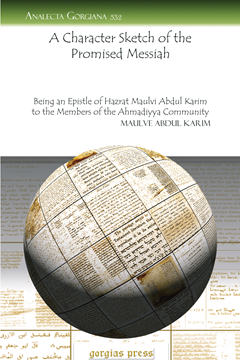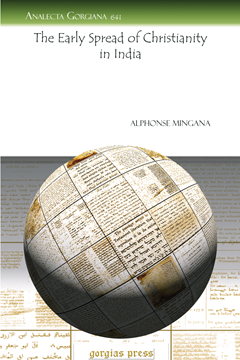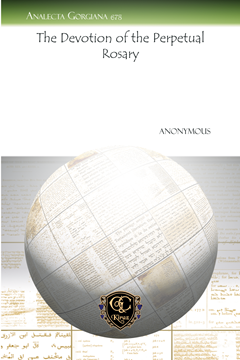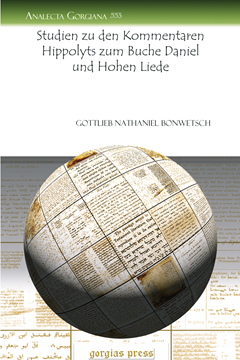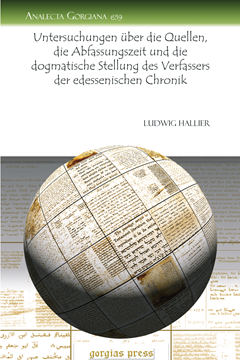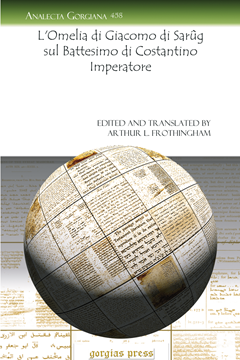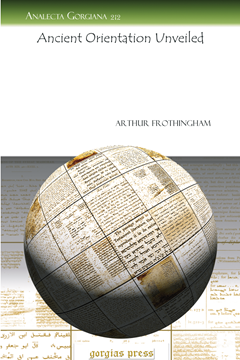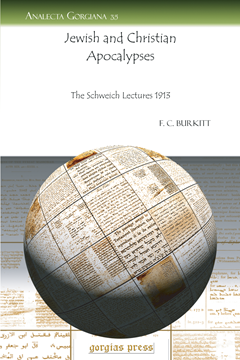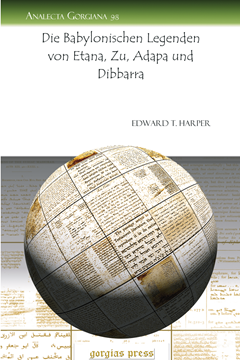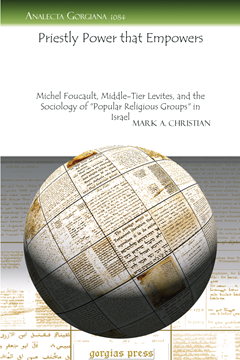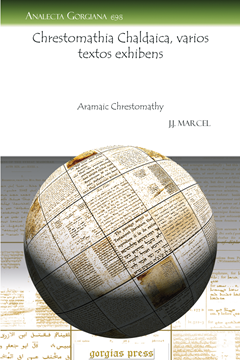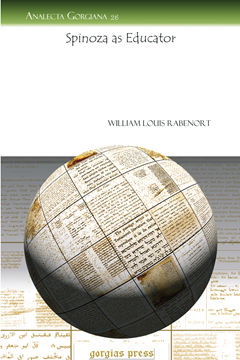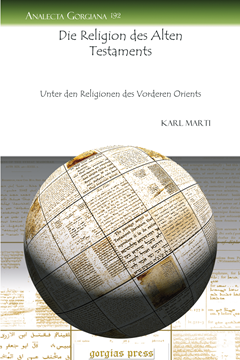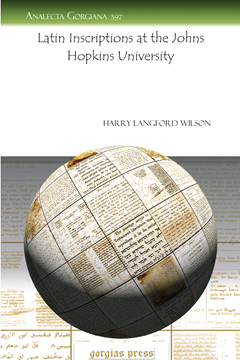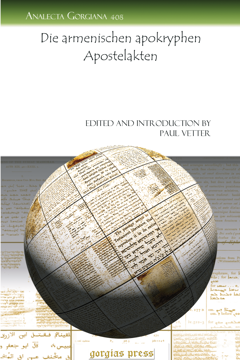Analecta Gorgiana
Analecta Gorgiana is a collection of long essays and short monographs which are consistently cited by modern scholars but previously difficult to find because of their original appearance in obscure publications. Carefully selected by a team of scholars based on their relevance to modern scholarship, these essays can now be fully utilized by scholars and proudly owned by libraries.
The Indo-Iranian Nasal Verbs
By Edwin Fay
Series: Analecta Gorgiana 379
ISBN: 978-1-60724-628-2
Edwin Fay's mathematical model for the patterns of mutations in nasal Sanskrit verbs.
$50.00 (USD) $30.00 (USD)
Byzantinische Troparia und Kontakia in Syro-Melchitischer Überlieferung
Series: Analecta Gorgiana 473
ISBN: 978-1-60724-928-3
Joseph Molitor traces the influence of Byzantine troparia and kontakia (hymns) in the Syriac Melkite tradition as evidenced by several Syriac manuscripts. Molitor provides a thorough introduction and publishes the Syriac text and German translation for the hymns he surveys.
$50.00 (USD) $30.00 (USD)
A Character Sketch of the Promised Messiah
Being an Epistle of Hazrat Maulvi Abdul Karim to the Members of the Ahmadiyya Community
Series: Analecta Gorgiana 532
ISBN: 978-1-61719-193-0
The life, sayings, and character of Hazrat Mirza Ghulam Ahmad, founder of the Ahmadi movement, which were written during his lifetime in Urdu by a close follower are documented here.
$50.00 (USD) $30.00 (USD)
The Early Spread of Christianity in India
Series: Analecta Gorgiana 641
ISBN: 978-1-61719-590-7
Mingana here looks at the early history of Christianity in India, with references to most (if not all) of the passages in Syriac and Christian Arabic literature, as well as other documentary evidence, pertaining to the subject.
$50.00 (USD) $30.00 (USD)
Die Apologie des Aristides
Edited with an Introduction by Edgar Hennecke
Series: Analecta Gorgiana 597
ISBN: 978-1-61719-495-5
This work is a reconstruction of Greek, Armenian, and Syriac versions of an early Christian text that explains to the Emperor why Christianity is the only philosophically adequate religion.
$50.00 (USD) $30.00 (USD)
Syriac Noun and Verb Paradigms in the Eastern Pronunciation (Chaldean)
By Anonymous
Series: Analecta Gorgiana 670
ISBN: 978-1-61719-620-1
This handbook for grammatical forms in Syriac provides students and scholars with a quick reference for the various forms of nouns, pronouns, and verbs, and also offers a simple way to learn Syriac grammatical terminology.
$51.00 (USD) $30.60 (USD)
The Devotion of the Perpetual Rosary
By Anonymous
Series: Analecta Gorgiana 678
ISBN: 978-1-61719-629-4
This volume in Arabic, originally printed at the Dominican Press in Mosul, contains chapters on the origin of Rosary devotion, its benefits, some questions and answers on the Rosary, and the way to recite the Rosary.
$51.00 (USD) $30.60 (USD)
Studien zu den Kommentaren Hippolyts zum Buche Daniel und Hohen Liede
Series: Analecta Gorgiana 553
ISBN: 978-1-61719-274-6
The doctrine and origin of two of the commentaries of Hippolytus of Rome, whose troubled career has left him with the reputation of both Saint and Antipope
$51.00 (USD) $30.60 (USD)
Untersuchungen über die Quellen, die Abfassungszeit und die dogmatische Stellung des Verfassers der
Series: Analecta Gorgiana 659
ISBN: 978-1-61719-608-9
This study of the mid-6th century Chronicle of Edessa explores its sources, date of composition, and doctrinal stance.
$51.00 (USD) $30.60 (USD)
L'Omelia di Giacomo di Sarûg sul Battesimo di Costantino Imperatore
Edited and Translated by Arthur L. Frothingham
Series: Analecta Gorgiana 458
ISBN: 978-1-60724-896-5
Frothingham here offers the Syriac text, with an annotated Italian translation, of Jacob of Sarug’s homily on the Baptism of Constantine (832 lines), based chiefly two manuscripts, one from the Vatican and the other from the British Museum.
$51.00 (USD) $30.60 (USD)
Erechtheum Papers
Series: Analecta Gorgiana 225
ISBN: 978-1-60724-454-7
This series of papers presents a thorough and enlightening overview of the nature of the Erechtheion's remains, its history of renovation and destruction, and the purposes to which it may have been put.
$51.00 (USD) $30.60 (USD)
Ancient Orientation Unveiled
Series: Analecta Gorgiana 212
ISBN: 978-1-60724-441-7
Frothingham presents an ambitious overview of the development of orientation, or the directionality of sacrifice, prayer, and ritual, played a key role in ancient ceremonies, in the practice of ancient religions.
$51.00 (USD) $30.60 (USD)
Jewish and Christian Apocalypses
The Schweich Lectures 1913
Series: Analecta Gorgiana 35
ISBN: 978-1-59333-664-6
In this time of intense apocalyptic interests, Burkitt’s study of extra-biblical apocalypses will shed some light. Burkitt is known for his work in early Christianity, and he is well-equipped to deal with this difficult issue. These Schweich Lectures of 1913 address the book of Enoch, minor Jewish and early Christian apocalypses, especially the Ascension of Isaiah.
$51.00 (USD) $30.60 (USD)
Die Babylonischen Legenden von Etana, Zu, Adapa und Dibbarra
Series: Analecta Gorgiana 98
ISBN: 978-1-60724-022-8
In this continuously cited article on the Babylonian legends of Etana, Zu, Adapa and the South Wind, and Dibbarra, Harper provides a substantial wealth of detail. Each of these myths is treated with an introduction, transliteration, and translation. Philological notes are given along with a summary of the contents. Comparison is also made with other ancient tales that bear resemblance to those contained in this volume. Further remarks by H. Zimmern on the Adapa legend are also included. This study is accompanied by hand-drawn copies of the cuneiform tablets and a photographic archive of the various fragments of the texts.
$51.00 (USD) $30.60 (USD)
Priestly Power that Empowers
Michel Foucault, Middle-Tier Levites, and the Sociology of ‘Popular Religious Groups’ in Israel
Series: Analecta Gorgiana 1084
ISBN: 978-1-4632-0131-9
Christian analyzes priestly social dynamics in-depth as they develop through tribal history and specialization of tasks. He focuses on middle-tier Levites as their skills and specialized knowledge place them in upper classes but their work relegates them as intermediaries.
$51.00 (USD) $30.60 (USD)
Chrestomathia Chaldaica, varios textos exhibens
Aramaic Chrestomathy
By J.J. Marcel
Series: Analecta Gorgiana 698
ISBN: 978-1-61719-674-4
In this early reading book for Aramaic (that is, not Syriac), J.J. Marcel provides a few texts from the Bible together with an Aramaic-Latin glossary.
$52.00 (USD) $31.20 (USD)
Spinoza as Educator
Series: Analecta Gorgiana 26
ISBN: 978-1-59333-589-2
When educator William Rabenort looked at Spinoza he saw an educator. This little book on educational theory is built on the thought of Spinoza.
$52.00 (USD) $31.20 (USD)
Le Testament de Saint Éphrem
Series: Analecta Gorgiana 9
ISBN: 1-59333-486-9
A critical edition of the Syriac Testament of St. Ephrem, along with a French translation and notes, secure Duval’s study a place in the literature concerning this document. This historic study provides a translation in accessible French along with the necessary critical apparatus for scholars.
$52.00 (USD) $31.20 (USD)
Life of Saint Nino
Series: Analecta Gorgiana 3
ISBN: 1-59333-471-0
This translation makes readily available the basic hagiography of St. Nino. Apart from her personal significance, St. Nino represents the important place that women held in the introduction of Christianity to Georgia. Text critical material is offered, and chapters 8 through 11 of the Armenian version are presented.
$52.00 (USD) $31.20 (USD)
Die Religion des Alten Testaments
Unter den Religionen des Vorderen Orients
By Karl Marti
Series: Analecta Gorgiana 192
ISBN: 978-1-60724-288-8
The aim of this booklet is to given an account of the nature of the religion of the Old Testament, especially those aspects that differentiate it from other ancient religions. Fitting with the emerging historical-critical Zeitgeist, Marti follows the usual division of Israelite religion into nomadic, peasant, prophetic, and legal religions. Various accoutrements and components of the religious life of antiquity are considered throughout this somewhat contrived course of Israel’s religious development. Written when Assyriology was just beginning to come into its own, Marti still finds the Graf-Wellhausen hypothesis a compelling explanation for the form of the biblical material.
$52.00 (USD) $31.20 (USD)
Catholic Catechism in Urmia Aramaic
By Anonymous
Series: Analecta Gorgiana 672
ISBN: 978-1-61719-622-5
This catechism in the Aramaic dialect of Urmia, originally published at the Lazarist Press there, provides questions and answers regarding the Catholic faith in that language.
$52.00 (USD) $31.20 (USD)
An Arabic Treatise on the Soul
Edited with an Introduction by Ignatius Aphram I Barsoum
Series: Analecta Gorgiana 580
ISBN: 978-1-61719-539-6
Here Syrian Orthodox Patriarch and scholar Ignatius Aphrem I Barsoum (1887-1957) presents an annotated edition, with introduction, of one of the Arabic treatises on the soul by Barhebraeus.
$52.00 (USD) $31.20 (USD)
Mémoire sur les Migrations des Tsiganes à travers l’Asie
Series: Analecta Gorgiana 527
ISBN: 978-1-61719-080-3
History of the Gypsies in Asia and the Middle East
$53.00 (USD) $31.80 (USD)
Latin Inscriptions at the Johns Hopkins University
Series: Analecta Gorgiana 397
ISBN: 978-1-60724-646-6
This series of papers gives photographs, transcriptions, translations, and commentaries upon Roman inscriptions owned by the Johns Hopkins University.
$53.00 (USD) $31.80 (USD)
Die armenischen apokryphen Apostelakten II. Die Akten der Apostel Petrus und Paulus
Edited with an Introduction by Paul Vetter
Series: Analecta Gorgiana 408
ISBN: 978-1-60724-683-1
Paul Vetter presents here a critical edition of the Armenian version of the Acts of Peter and Paul along with a Greek translation. Vetter’s introduction to the text includes a discussion of the complex transmission history evident in the manuscripts.
$53.00 (USD) $31.80 (USD)



